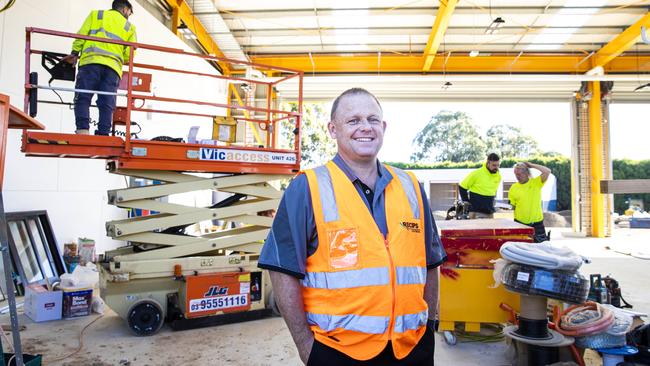New car, new tools, new investment on back of budget
Businesses are set to invest after a budget move to extend schemes allowing them to write off purchases and carry-back losses.

RECIPS Electrical director Dean Spicer is planning on splashing out on a suite of new testing tools and a new Toyota HiLux for the business on the back of the federal budget.
The move on Tuesday night from the federal government to extend its instant asset write-off scheme, which allows businesses to claim the full value of purchases, until 2023 has also inspired thousands of other businesses around the country.
Mr Spicer welcomed the opportunity afforded by the budget measures, saying he was looking to use the write-offs to invest in his business and put on more people.
“In the past we used the scheme to buy a new HiLux,” he said. “We’ll certainly use (the write-off scheme) to upgrade our fleet, if we can actually get cars, and we might look at some bigger tools to upgrade.”
The push by the government to extend the program is aimed at boosting job creation and spurring sluggish business investment.
Businesses with annual turnovers of up to $5bn, which takes in almost every small-and-medium enterprises in the country, can take advantage of the scheme.
The write-offs come on top of the government’s loss carry-back scheme, enabling businesses to offset losses from past profits.
These two measures are expected to provide almost $20.7bn of tax relief over the forward estimates.
Mr Spicer said his business had spent almost $100,000 over the past year.
“We could do it again at a similar amount,” he said. “We haven’t had an opportunity to plan for it yet, obviously it’s only just been announced. We need to put it into our planning.”
The Melbourne-based electrical business has been growing in recent months as Victoria’s economy recovers from its long months of lockdown.
At almost 15 staff between back office and on site, RECIPS has been a big beneficiary of the booming construction industry.
“We’ve taken on more people — we’ve got some casual labour in, about another four people (and) we put on an apprentice as well,” he said.
Mr Spicer said the broader economic boom in the wake of government economic support was creating space for small and medium businesses like his to grow. “The big infrastructure projects have positive effects on other businesses which brings work to us,” he said.
National Electrical and Communications Association policy and government relations director Peter McCabe said the budget presented a “grab bag of goodies” that would help small and medium businesses with cash flow and support their skills training and apprenticeships.
“The investment in infrastructure, housing and renewables provides a solid platform for growth across the electrotechnology sector,” he said.
“It really reinforces the crucial role construction and trade businesses will continue to play in underwriting Australia’s economic success.”
KPMG enterprise national tax leader Clive Bird said he was confident businesses would continue to use the scheme as it was easy to use for purchases both great and small.
“My clients are taking advantage of that,” he said. “Sometimes it is taking the initiative to say, ‘This is an opportunity to invest in something we might not otherwise have done,’ and other times it would be that plans were in place anyway and doing it now brings a better tax outcome.
“But either way, in both cases, what it does, is it puts money back in the hands of businesses, allowing them to invest in growth, innovation and upgrading their facilities.”
Judo Bank Economics Adviser and EQ Economics managing director Warren Hogan said the asset write-off and loss carry-back schemes would “level the playing field” between small and medium-sized enterprises (SMEs) and big businesses.
“I think that is a major issue that is underappreciated but a big source of concern for SMEs,” he said.
Mr Hogan said data from the December quarter showed the effectiveness of the policy introduced in the October budget last year, after investment in plant equipment rose by more than 8 per cent.
“We’re also hearing stories in industries like motor vehicles, second-hand cars, their sales have been very strong,” he said.
“What we are not clear on is whether or not it has a profound influence on bigger investment and the reality is that takes some time to execute. Businesses have to take time to plan for that.”
But the rapid pace of economic recovery, coupled with continued border restrictions and the spread of COVID-19 beyond Australia’s shores in playing havoc with other parts of the economy.
The car market, which has been hit by supply shortages and booming demand, is set to be further fuelled by the budget boom.
Vehicle retailing website Carsales has been riding high on the pandemic-fuelled demand for wheels. Carsales chief Cameron McIntyre said the extension of the write-off program was “incrementally positive for vehicle sales”, echoing comments from other industry players.
“Obviously it encourages investment in vehicles so that’s a positive for the industry,” he said.
“We’ve absolutely seen higher ute sales.”
Eagers Automotive CEO Keith Thornton said the extension of the full expensing measure was an effective initiative to support the recovery of the automotive retail sector.
“When you consider that around 40 per cent of new vehicle purchases are for work purposes, this measure provides an attractive opportunity for small and large businesses alike to invest,” he said.



To join the conversation, please log in. Don't have an account? Register
Join the conversation, you are commenting as Logout